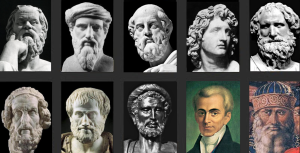
Philosopher, Mathematician, Engineer, Inventor, Astronomer, Musician, Scholar (c.790 – unknown)
Leo the Mathematician, otherwise known as Leo the Philosopher, was a polymath from Thessaly, the greatest mathematical and philosophical mind to ever pass from Greece during the Byzantine era. Leo proved to be more than a theoretical mind, putting his mathematical knowledge into action by inventing some of the most extraordinary machines of his time.
In attempt to receive the best education as possible, Leo travelled to many monasteric libraries around the Byzantine Empire, where he studied the manuscripts. These manuscripts provided him with advanced knowledge on mathematics, philosophy, astronomy etc. He later studied formally in Constantinople until the Byzantine Emperor Theophilus invited him to become a teacher of private education.
Leo served numerous high rank positions due to his political influence. Most notably Leo served as archbishop of Thessalonica, Rector of the Pandidakterion school of Constantinople and head of the philosophical school of Magnaura Palace, where he taught philosophy, geometry, arithmetic, rhetoric and grammar. Cyril, who would later become a saint together with his brother Methodius, was one of his students.
In mathematics, he was the first to introduce numbers instead of letters in arithmetic and algebra. He transcribed and thus saved a plethora of Ancient Greek manuscripts, such as those of Plato, Apollonius of Perga, Euclid, Archimedes, Ptolemy and many others. Leo also made corrections on several astronomical errors and proposed his own ideas and models on the movement of planets.
Leo became well known for his groundbreaking inventions. He constructed a system of fire signal stations called Fryktories which enabled communication between these stations in less than an hour, considered as the first optic telegraph in history. These fire beacons stretched across Asia Minor, from Cilicia to Constantinople. Leo is mostly renowned and remembered in history for his automata, robots and machines that could function automatically. He built mechanical trees and birds, roaring lions, including an imperial throne which could levitate. According to Liutprand of Cremone, who witnessed his inventions 100 years after his death, the throne was decorated with bronze, mechanical trees filled with twittering birds. The throne was enormous, made of bronze and gold, guarded by mechanical lions that struck the ground with their tails and roared with open mouth. He describes how he witnessed the king, right before his eyes, being lifted as high as the ceiling of the hall in astonishment.
Unfortunately, most of Leo’s works have been lost. He is often overshadowed by other people named Leo, most notably Emperor Leo the Wise, who proved to be more popular in history. Nevertheless, Leo the Mathematician is acknowledged as one of the greatest medieval scientists in history.
Bibliography
- “Leon o Mathimaticos”. Helios New Encyclopaedic Dictionary. Passas, I. Athens, 1946. Print.
- Ouranos11144. Leo the Mathematician. Youtube. April 27, 2013. Web. October 9, 2015.
